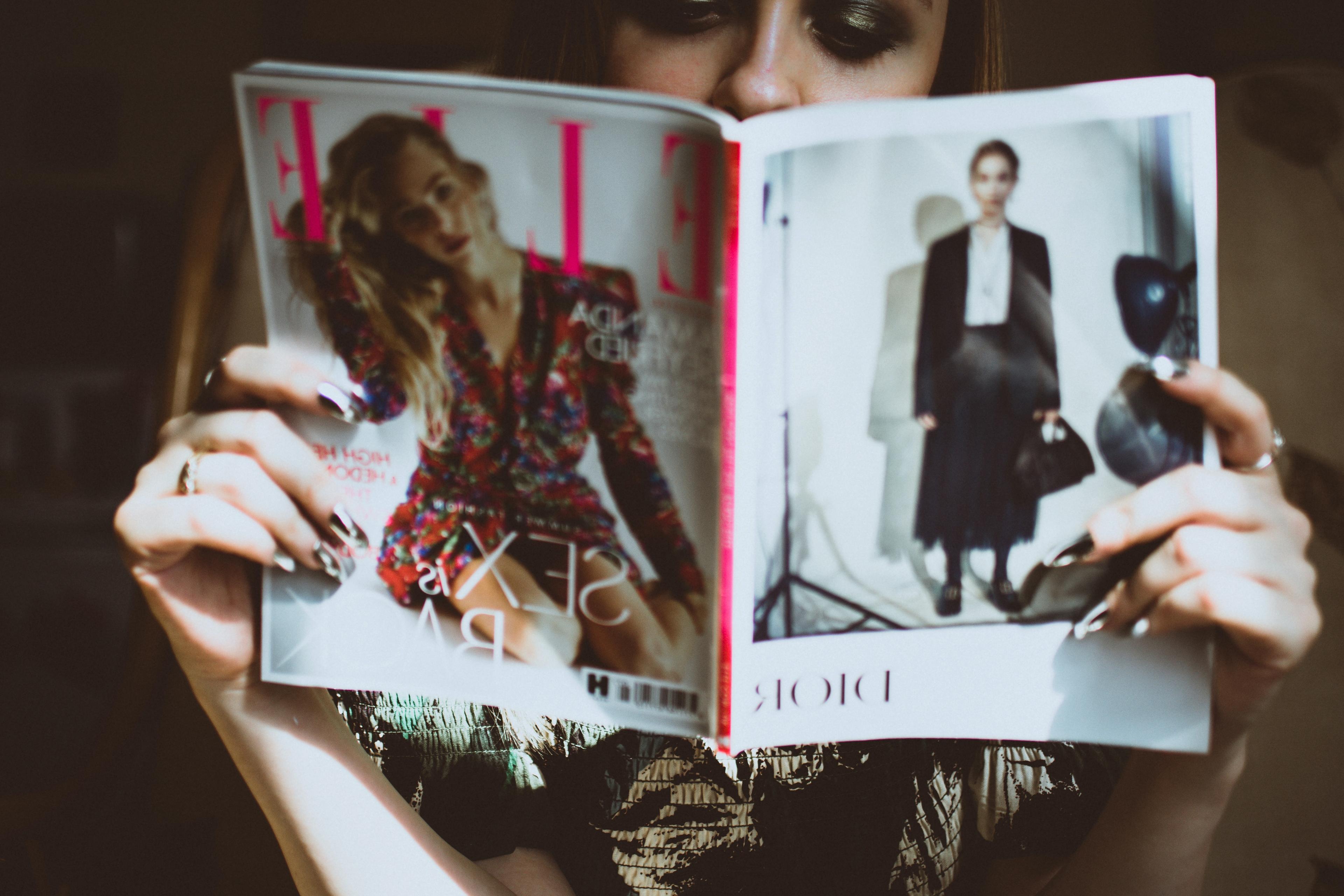
In 1996, the arrival of a new Delia’s catalog—the trendy clothing source for girls in the 90s—was a major event in my home. After my older sister had her turn, I would pore over the images, scrutinizing each page, pencil in hand to mark the items I wanted—but, in reality, I was far less interested in the clothing than in the bodies wearing them. We were in the thick of the “heroin chic” era, and though the catalog was aimed at tween girls, the young models within reflected the decidedly adult aesthetic of the time. I took in the flat-as-a-board bellies, the attenuated arms; I memorized how they looked and then compared those vivid images to my 10-year-old body in the mirror. The discrepancies were vast. I was failing.
The “heroin chic” look dominated the fashion scene throughout the 90s, when I and many millions of other young girls were passing through those formative years of adolescence and early teenagehood. Characterized by pale, strikingly slim, curve-free models who tended to be described in terms like “waifish,” the aesthetic came to the fore as opioid use was rising in the United States, and is said to have been originated by model Gia Carangi, who was addicted to heroin herself and died of AIDS in 1986. After some other high-profile heroin-related deaths—including a prominent fashion designer at the time—as well as a full-throated condemnation of the trend from then-President Bill Clinton (“Glorifying death is not good for any society,” he said in a national address), the trend faded, as all trends eventually do.
But for many, the damage had been done.
“Heroin chic was in full swing during my puberty years, so going from rail thin to curvy was especially hard,” my friend Christina, a brand strategist based in Abu Dhabi, told me. “It amplified the already difficult pubescent years, and I’d say is still pretty hardwired in my brain for what’s idealistic.” My friend Kat, an LA-based director of audience development, who also entered teenagehood during the ‘90s, remembers thinking that Kate Moss and the heroin chic campaigns she led for Calvin Klein at the time were “the pinnacle of cool.” Katie Baxter wrote in Cosmopolitan that she remembers “returning home from a grueling and lonely day at school to compare myself to the emaciated frames on the internet.” For my part, I descended into full-blown anorexia, which was by no means caused by the fashion of the time, but certainly fueled by it.
For all these reasons, many like me who went through round one of heroin chic reacted with outrage when, in November, the New York Post ran a cover story with photos of Kate Moss and the newly slimmed-down Kardashians, a headline blaring across them: Bye-bye booty: Heroin chic is back. Jameela Jamil, one of the most outspoken voices on eating disorders and body image, wrote, “I am mortified to announce that the recent revival of ’90s fashion trends has brought back with it ’90s eating disorder culture. ‘Heroin Chic’ had my generation in a chokehold. Most of us still haven’t fully recovered.” In the aftermath, influencers and regular social media users alike voiced their anger at the heralded return of the trend, and a cascade of thought pieces questioned its meaning. While heroin itself is no longer a core component of the look, women are once again being pressured to attain dangerously thin bodies in order to be “fashionable.”
This swing in fashion ideals is natural. Just as the first run of “heroin chic” was a reaction to the busty, pageant-esque models who dominated the scene beforehand—think Cindy Crawford on Sports Illustrated—this go-round appears to be a reaction to the notoriously curvy bodies of the Kardashians (and, it must be noted, it was when the Kardashians started to slim down that this “trend” really began to gain steam). “With fashion, things are constantly changing,” said my friend and former boss Elizabeth, who was a style editor to my style intern at a glossy magazine and has spent decades working in fashion. “It will go from realistic to some extreme look. If heroin chic is indeed coming back, we’re going to move away from it eventually. We’ve moved on from it before and we’ll move on again.”
That’s true. The pendulum of fashion will swing in the other direction. But in the meantime, here we are: Another generation of young people is absorbing unattainable, even sickly images and fashion ideals—through fashion models and magazines, as with heroin chic’s first appearance, but now also through social media platforms like Instagram and TikTok, and the filters that come along with them—and these images may forever shape how they feel about their bodies. It’s not enough to wait for heroin chic to be replaced by the next trend: Much has been written on the ways in which the heroin chic trend affected a generation’s sense of body image, and experts agree that its return could do significant harm, especially since poor body image is the best-known contributor to the development of anorexia and bulimia. In order to protect this generation and those that come after them, we need to fundamentally change how we think about fashion and bodies.
Because here’s the thing: The rise of heroin chic is getting a lot of attention because for many people — indeed, the majority of people — attaining that waifish physique is downright dangerous and almost impossible without engaging in disordered eating or even developing an eating disorder. But the truth is, female-presenting bodies are always subject to changing ideals; for women, keeping up with fashion trends doesn’t simply mean trying out a new cut of pants or a particular color or hairstyle, it means changing the shape of one’s body, again and again and again.
This, of course, is impossible, and attempting it is tremendously unhealthy. Yet we can’t expect (or even want) to stop the cyclical nature of fashion—fashion is exciting, fun, and beautiful, and it would not be so were it static—but we can reject the idea that bodies need to look a certain way to wear those fashions. “Talking about body types as fashionable or not is so reductive and useless,” Elizabeth said to me. “It’s a joke. Your body type is your body type.” Ally Duvall, Equip’s Body Image Program Manager, points out that treating thinness as an accessory not only causes harm, but also misses the point of fashion: "How boring would it be if we all had the same body, wearing the same fashion trends? To me, body diversity is the foundation to our endless range of styling opportunities."
Vogue’s culture writer Emma Specter put this idea into plain language when she tweeted, “Do [the] people who insist the return of crop tops and low-rise jeans means we all have to adhere to early-aughts levels of compulsory thinness realize i will just………wear those things w my large and beautiful stomach hanging out?”
That's the message we must embrace if we are going to ride the inevitable waves of fashion with our body image and self-worth intact. We’re not oppressed by changing fashion trends—we’re oppressed by the idea that our bodies must look a certain way in order to wear those trends, an idea that gains strength from the fact that many brands and designers don’t have size-inclusive lines. Thankfully, this idea is baseless, and easily invalidated if we simply choose the fashion trends we like, and wear them regardless of our body size.
“I spent my whole life waiting to wear overalls because I believed I didn’t have the body that would vibe with overalls,” Duvall says. “But turns out, my body and overalls were meant to be. Everyone deserves the denim overall hug and endless pockets.” I never needed to change my body to buy that clothing from Delia’s, just as I don’t need to change it today if I’m interested in jumping on the trends of the moment.
Fashion is displayed on bodies; bodies are not fashion. If, as a society, we can learn to separate the two, we can weather whatever comes down the runway at us next.
A version of this article originally appeared on Katie Couric Media.







